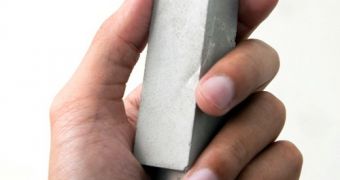Since flash drives established themselves as a market, storage solutions developers have been diligent in the invention of new ways to ensure that these devices, along with the data stored onto them, are secure. Among the more successful design features and technologies that have come to be as a result of this need are hardware encryption, rugged casings, password protection and even biometric authentication. Now, however, at least one person on the planet thinks that more drastic steps should be taken.
A certain designer by the name of Shu-Chun Hsiao has brought out a design concept that turns flash drives into hard drives, in a very literal sense. Hard, here, refers not to those platter-spinning small machines with multi-terabyte capacities, but to the actual nature of the flash drives' enclosures. Basically, the idea is for a flash drive to be completely covered in cement.
The designer did not just pull this idea out of a hat, of course. The cement, in fact, is not only meant to provide resistance to most types of abuse (impact being the least of them), but also serves as an indicator of the unit's storage space. To be more specific, the idea is for each product to weigh as many grams as there are available gigabytes. Thus, a 64GB unit would weigh 64 grams (engraved into the cement itself) and a 256GB model would weigh 256GB.
This idea may never actually gain traction and, while it may be interesting to see people walking around with pieces of concrete in their hands, one might not want to be around when such a unit is dropped, especially when barefoot or wearing sandals. There is also the issue of the weight being too much for the poor USB connector to support when being plugged into a USB port, though this wouldn't be an issue for desktops with top-mounted I/O panels.

 14 DAY TRIAL //
14 DAY TRIAL //